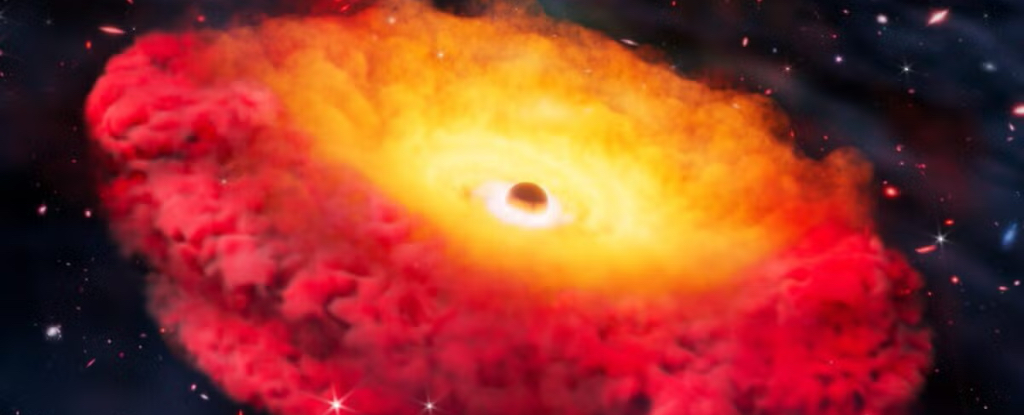
Astronomers have confirmed the existence of the earliest known supermassive black hole, identified as CAPERS-LRD-z9. This black hole, residing in a galaxy that emerged approximately 500 million years after the Big Bang, boasts an astounding mass of roughly 300 million solar masses. This discovery not only expands our understanding of black hole formation but also provides insights into a previously enigmatic class of celestial objects termed Little Red Dots (LRDs).
Significance of the Discovery
Located in one of the universe’s earliest epochs, CAPERS-LRD-z9 was identified with the help of the James Webb Space Telescope (JWST). The black hole is classified as an active galactic nucleus (AGN), characterized by its bright, rapidly feeding core. The enormous mass of this black hole raises intriguing questions about how such a colossal entity could form so quickly in cosmic terms, given that it existed when the universe was merely 3 percent of its current age.
The LRDs, which appear around 600 million years after the Big Bang and begin to vanish less than a billion years later, have been revealed through JWST’s advanced infrared capabilities. These small, bright red objects are crucial to understanding the early universe and the conditions that led to the formation of galaxies, including our own Milky Way.
Insights from Spectroscopy
The research team, led by Anthony Taylor, an astrophysicist at the University of Texas at Austin, utilized spectroscopy to analyze light emitted from the gas surrounding CAPERS-LRD-z9. This method involves splitting incoming light into its component wavelengths to reveal details about the object’s velocity. The light emitted from the gas surrounding the black hole shows a redshift, indicating that it is moving away from observers at approximately 3,000 kilometers (1,864 miles) per second, or about 1 percent of the speed of light.
Taylor emphasized the uniqueness of this signature: “There aren’t many other things that create this signature.” The findings suggest that LRDs may host supermassive black holes that are significantly larger than previously understood, with some reaching upwards of 10 million solar masses within their first billion years.
In comparison, the supermassive black hole at the center of the Milky Way is approximately 4 million solar masses. The mass ratio of the black holes found in LRDs could be as high as 10 to 100 percent of their host galaxy’s stellar mass, indicating a remarkable scale of growth. The black hole in CAPERS-LRD-z9 alone constitutes about half the total stellar mass of its galaxy.
Research indicates that the compact nature of CAPERS-LRD-z9 presents challenges for even advanced telescopes like JWST, which cannot fully resolve it. This black hole is estimated to measure no more than 1,140 light-years wide, placing it in the realm of dwarf galaxies that orbit the Milky Way.
Theoretical Growth Mechanisms
The rapid growth of black holes such as CAPERS-LRD-z9 can occur through two theoretical pathways. One possibility involves a large initial “seed” black hole that grows at the Eddington rate, suggesting it may have started with a mass of around 10,000 solar masses. The alternative scenario posits that a smaller seed, starting at just 100 solar masses, could grow even more rapidly if it is surrounded by a dense envelope of gas, accelerating its growth to a super-Eddington rate.
These primordial black holes may have originated from various processes, including the collapse of Population III stars, which are theorized to be the first stars to shine in the universe, or from the direct collapse of massive primordial gas clouds.
The research published in the Astrophysical Journal Letters highlights that this discovery pushes the boundaries of current astronomical technology, allowing scientists to peer further back into the early universe than ever before. The findings suggest that LRDs could represent an ephemeral phase in cosmic evolution, potentially acting as precursors to the formation of larger galactic structures, including the Milky Way.
As research continues, astronomers are optimistic that further discoveries will enhance our understanding of supermassive black holes and the role they play in shaping the universe as we know it.







